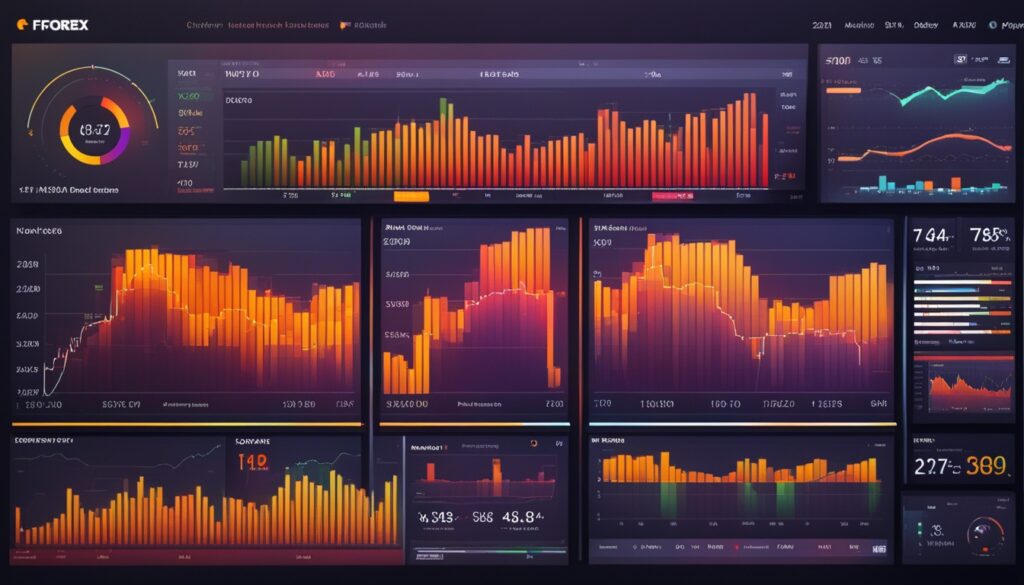The forex market is the biggest, with trillions traded every day. Knowing the market’s mood is key for traders. Sentiment analysis looks at emotions and psychology in Forex trading.
Sources like news and social media offer insights into currency feelings. Such analysis gives real-time views, showing trading chances and the impact of news.
Most strategies use technical and fundamental analysis. But adding sentiment analysis brings something new. If people feel good about a currency, its value might go up. Bad feelings can make it drop.
In the huge forex market, use sentiment analysis with other tools. It helps predict and react to market changes. Seeing the overall mood helps greatly in trading.
What is Sentiment Analysis in Forex Trading?
Sentiment analysis in Forex trading is quite important. It looks at the collective feelings and thoughts of people in the market. By doing this, traders can understand the market’s mood towards different currency pairs. This can really help improve their trading strategies. Traders get this info from news, social media, and reports. They focus on Retail Trader Sentiment and Institutional Investor Sentiment.
Definition and Importance
Sentiment analysis deals with traders’ emotions and viewpoints. It uses Forex Sentiment Indicators to grasp the market mood. This is key. Often, the general sentiment shows if prices might change soon. For example, if most traders think a currency will rise, it might actually fall.
Knowing about Retail Trader Sentiment and Institutional Investor Sentiment is crucial. It gives quick insights for trading choices. This is extra help beyond old-style analysis. Since many retail Forex traders lose money, sentiment analysis can be a big help. It helps traders figure out the complex feelings that move the market.
How Sentiment Analysis Differs from Technical and Fundamental Analysis
Sentiment analysis is different. It’s not about price patterns or economic stats. Instead, it taps into the market’s psyche. This offers new insights. Technical analysis predicts trends from past prices. Fundamental analysis looks at the economy to value currencies. But sentiment analysis shows the market’s overall mood, adding to the other two.
Take the Commitment of Traders (COT) reports from the CFTC, for example. They show what big players and commercial traders are doing. This info can change market trends. Forex brokers also share summaries of trader positions. These show the share of traders betting on currencies rising or falling.
The Forex market sees $7.5 trillion trades daily. It’s very liquid and responds to sentiment quickly. Using sentiment analysis can lead to better trading decisions. By knowing the Retail Trader Sentiment and Institutional Investor Sentiment, traders can guess market moves better. They can then adjust their strategies.
| Currency Pair | Traders (%) |
|---|---|
| EURUSD | 33% |
| GBPUSD | 22% |
| USDJPY | 7% |
| GBPAUD | 4% |
| XAUUSD | 16% |
The Role of Market Sentiment in Forex Trading

In Forex trading, knowing market sentiment is key. The currency market reacts quickly to news. It sees about $7.5 trillion in trades daily, says a 2022 report by BIS. One way to predict currency changes is by studying Forex Crowd Sentiment.
Sentiment indicators are very helpful. They include the weekly COT report and brokers’ summaries. When most traders think a currency will rise, it’s a bullish outlook. A bullish outlook means people believe its value will go up. A bearish sentiment means they expect it to fall.
The Contrarian Sentiment Trading technique is about betting against the crowd. It uses sentiment indicators to spot possible trend reversals. It works by either following the current trend or trading against it when everyone leans one way too much.
Imagine the market reacting to strong GDP growth. This good news makes more people buy a currency. But bad news can scare them away, causing a drop in value. Traders use patterns to confirm these changes in mood.
Understanding market sentiment is crucial. It lets traders predict prices, tailor their strategies, and deal with market volatility.
Forex Trading Sentiment: Tools and Techniques

Forex trading sentiment is important for knowing market changes. Every day, $7.5 trillion in forex trades happen, says the BIS. Traders use both automated and manual ways to understand market feelings. This can really help improve how well they do in trading.
Automated Sentiment Analysis Tools
Automated tools for analyzing sentiment are now very popular. They can quickly go through lots of data. These tools look at news, social media, and more to give real-time feelings of the market. They sort these feelings, helping traders change their plans according to the mood of the market. For example, if more people are buying futures and prices go up, the trend might keep going.
Manual Sentiment Analysis Techniques
Manual techniques for analyzing sentiment are very useful too. Traders check things like volatility smiles for market tips. They also look at broker summaries to see how many are buying or selling a currency. For instance, if 82% are selling GBPUSD, it means most think its value will drop. These methods mixed with other analyses give a fuller trading strategy.
Using both automated tools and manual techniques makes for a complete strategy. It helps traders make smarter, more informed decisions.
Applying Sentiment Analysis to Trading Strategies

Adding sentiment analysis to your trading strategy development offers a competitive advantage. It helps understand the market mood. Sentiment indicators like the Commitment of Traders (COT) report and Fear and Greed Index play a big part. They help traders decide smarter based on market feelings.
Looking at the COT report shows what big traders are doing. For example, a 200,000 net contracts might mean a rally is coming. This knowledge helps adjust strategies and boosts your market analysis integration.
Sentiment indicators find chances to go against the crowd. If 60% traders are buying a currency, it might mean a price drop is near. This is key to deciding when to buy or sell.
Automated sentiment analysis uses smart algorithms to read the market in real time. It digs through news and social media. This gives traders current sentiment scores, which is super helpful for spotting market changes.,p>
Adding sentiment analysis to your toolkit is smart. It works well with looking at economy stuff like GDP and inflation. This mix helps you get ready for big market moves. It makes your strategies stronger and more flexible.
Here’s how some data stacks up:
| Indicator | Insight |
|---|---|
| Average Daily Forex Transactions | $7.5 trillion |
| Percentage of Traders Long on a Currency Pair | 60% |
| COT Report Positioning | 200,000 Net Contracts |
| Historical Price Reversal Trigger | 75% – 85% |
Using sentiment analysis well can really change your trading strategy development. Mixing it with other analysis types helps you make informed trading decisions. It also puts key market analysis insights into your forex trading strategy.
Risks and Challenges of Sentiment Analysis in Forex
Sentiment analysis is a powerful tool in Forex trading. But, it’s important to know its risks and challenges. The Forex market is huge and changes fast. Billions of dollars are traded every day. Sentiment analysis helps spot shifts in market mood that might show where prices will go. But just using sentiment analysis for trading can be risky.
Automated sentiment analysis tools are now more popular. They can look through lots of data fast and well. These tools use smart tech to figure out feelings from news, social media, and financial reports. But still, most people trading Forex lose money. This shows how hard it is to keep making money in Forex. Sentiment analysis can help, but it might not always be right.
Traders should use sentiment analysis with other ways of looking at the market. Many traders in the market help shape its overall mood. This mood can help traders decide on their moves. Sometimes, trading against what most people think can work, especially with a different strategy. For success, keep an eye on your strategies and make sure they are complete. This helps lower the chances of making choices based on emotion.